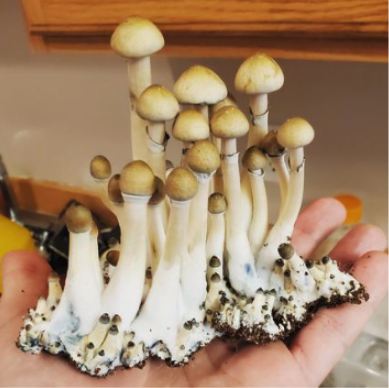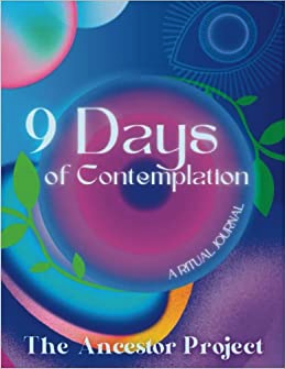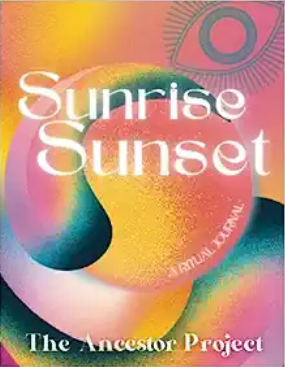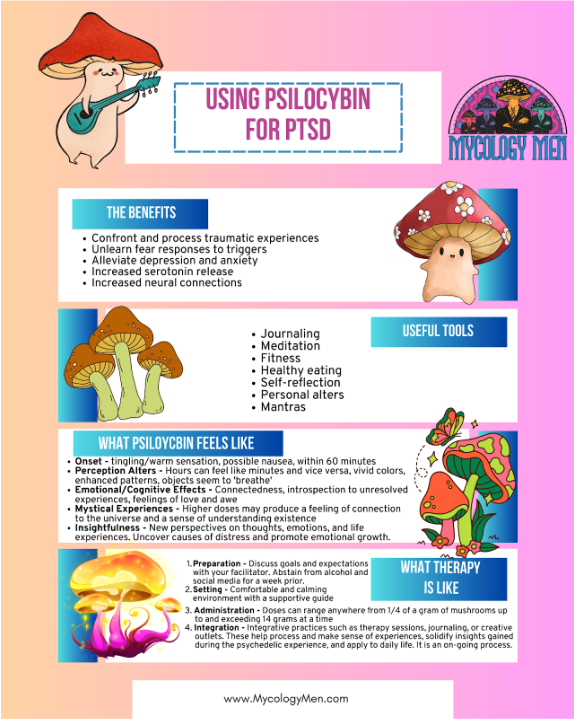Post-Traumatic Stress Disorder (PTSD) is a mental health condition that affects individuals who have experienced or witnessed traumatic events. The symptoms can be debilitating, affecting one's ability to function in daily life. While traditional treatments such as therapy and medication have shown some effectiveness, there is growing interest in exploring alternative approaches.
One such avenue gaining attention is the use of psilocybin mushrooms, which have shown promising potential in providing relief for those suffering from PTSD. In this article we will explore the use of psilocybin for PTSD. We take a look at the current research and we talk with some inspirational and educated individuals to help us get a better idea of how psilocybin can help.

PTSD is a psychiatric disorder that can develop after experiencing or witnessing a traumatic event. Common triggers include natural disasters, military combat, accidents, or violent personal assaults. The condition is characterized by intrusive memories, nightmares, flashbacks, avoidance of triggering stimuli, negative mood alterations, and hyperarousal. These symptoms often persist for months or even years, significantly impacting an individual's quality of life.

The conventional treatments for PTSD involve a combination of therapy and medication. Cognitive-behavioral therapy (CBT) is commonly used to help individuals process traumatic memories and develop coping mechanisms. Eye Movement Desensitization and Reprocessing (EMDR) is another therapeutic approach that focuses on redirecting traumatic memories.
Medications such as selective serotonin reuptake inhibitors (SSRIs) may be prescribed to alleviate symptoms of depression, anxiety, and sleep disturbances associated with PTSD. “These drugs work by increasing the amount of serotonin available to bind to serotonin receptors in the brain. Serotonin is a neurotransmitter that helps regulate your mood. When more serotonin binds to specialized receptors, it may help patients feel more stable and content”.*
Psilocybin, the active compound found in certain species of mushrooms, has demonstrated promise in assisting individuals with PTSD. Research indicates that psilocybin use can help individuals confront and process traumatic memories, leading to significant reductions in PTSD symptoms. Undrea Wright of the Ancestor Project talked with us to give some of his insights into using psilocybin to help with PTSD.
He emphasized that psilocybin is not a one-and-done fix-all solution. It is a tool to be used and an “ally” in your journey. It is something that can help you to use your own inner power to achieve your mental wellness goals. Ron Millward, co-founder of Balanced Veterans Network, is also a strong proponent of using psilocybin as a tool and not as a fix-all.
He has found activities such as meditation, journaling, and fitness to be extremely helpful to find your “inner power”. The psychedelic experience induced by psilocybin is thought to facilitate a deeper exploration of the mind, allowing individuals to gain new perspectives and insights into their traumatic experiences. This experience paired with proper preparation, integration techniques, and a healthy lifestyle has shown a lot of promise in helping those with PTSD by reducing the learned fear response and evaluating triggers.
Psilocybin interacts with various brain systems, leading to its potential therapeutic effects in conditions such as PTSD. While the precise mechanisms of action are not yet fully understood, several hypotheses have been proposed based on research findings.
Serotonin System Modulation: Psilocybin primarily acts as a serotonin 2A receptor agonist, stimulating these receptors in the brain. This activation leads to increased serotonin neurotransmission, which may contribute to the emotional and cognitive effects experienced during a psilocybin session. Serotonin plays a critical role in mood regulation, anxiety reduction, and emotional processing, all of which are relevant to PTSD.
Disruption of Default Mode Network (DMN): The DMN is a network of brain regions involved in self-referential thinking and mind-wandering. In individuals with PTSD, the DMN is often hyperactive and linked to excessive thinking about past traumatic events. Psilocybin has been shown to decrease DMN activity and connectivity, potentially disrupting thought patterns and allowing for new perspectives and psychological flexibility. This is a potential path to unlearning conditioned responses to triggers.
Neuroplasticity and Connectivity: Psilocybin has been found to increase functional connectivity between brain regions that are typically disconnected in conditions such as depression and PTSD. This increased connectivity may enhance communication and synchronization between brain regions involved in emotion regulation, memory processing, and fear extinction, promoting neuroplasticity (the brain’s ability to make new neural connections in the brain) and allowing for the processing of traumatic memories.
Emotional Processing and Fear Extinction: PTSD is associated with being unable to lessen your response to triggers (impaired fear extinction), leading to the persistence of traumatic memories and heightened fear responses. Psilocybin therapy may boost emotional processing and fear extinction by creating a heightened state of emotional openness, reducing fear responses, and promoting the reevaluation and integration of traumatic memories within a safe therapeutic context.
Enhanced Neurogenesis and Synaptogenesis: Some preclinical studies suggest that psilocybin may promote neurogenesis (the formation of new neurons) and synaptogenesis (the formation of new connections between neurons). These processes are important for brain plasticity, learning, and memory, and may play a role in the therapeutic effects of psilocybin by facilitating the rewiring and reorganization of neural circuits affected by trauma.
Several studies have explored its therapeutic effects of psilocybin. One such study* investigated the effects of psilocybin-assisted therapy in patients with life-threatening cancer and anxiety. It found significant reductions in anxiety, depression, and existential distress after a single psilocybin treatment, with effects lasting up to six months.
A related study* examined the impact of psilocybin on patients with treatment-resistant depression. Participants who received psilocybin-assisted therapy showed rapid and sustained reductions in depressive symptoms compared to the control group.
Another study* investigated the safety and efficacy of psilocybin-assisted therapy in treating PTSD. It found that participants experienced significant reductions in PTSD symptoms, with over 50% no longer meeting the criteria for PTSD diagnosis after treatment.
One promising study* examined the long-term outcomes of psilocybin-assisted therapy in patients with cancer-related psychiatric and existential distress. Results indicated sustained reductions in depression, anxiety, and existential distress, as well as improved quality of life up to four and a half years after treatment.
Psilocybin therapy typically involves a carefully structured, guided experience facilitated by trained professionals in a controlled and supportive environment. The therapy sessions or ceremonies aim to create a safe space for individuals to navigate their traumatic memories and emotions. The process consists of several key steps.
Preparation: Prior to the therapy session or ceremony, individuals meet with their therapists to establish rapport and discuss their treatment goals and expectations. They are educated about the potential effects of psilocybin and provided with guidelines on how to navigate the experience. Undrea Wright from the Ancestor Project suggests a week-long detox of social media, alcohol, and highly processed foods (and spicy food and gluten). This can help to prepare your body to achieve the most from your psychedelic experience.
Setting: The therapy session takes place in a comfortable and calming environment, often with subdued lighting, soft music, and carefully selected stimuli. This setting is designed to promote relaxation and minimize potential stressors. Organizations like the Ancestor Project and Balanced Veterans Network can help individuals find appropriate facilitators.


Administration: Psilocybin is ingested in the form of mushrooms or synthesized capsules under the supervision of the therapists. The dosage is carefully calibrated to achieve the desired therapeutic effects without overwhelming the individual. This amount can vary from person to person. It is not uncommon that a relatively large dose of 7 grams is utilized.
Undrea Wright mentioned that the amount of psilocybin needed for an effective dose may change over time. As you learn how to process works specifically for you, you may find you need less than you originally did. This could mean that when you once found 7 grams to be effective for you, you may only need a single gram of mushrooms further along in your wellness journey.
Supportive Presence: Throughout the session, therapists or facilitators remain present to provide emotional support and guide the individual through their experience. They offer reassurance, encouragement, and help facilitate a sense of safety.
Integration: Following the therapy session, individuals engage in integrative practices such as therapy sessions, journaling, or creative outlets. These activities help them process and make sense of their experiences, solidify insights gained during the psychedelic experience, and apply them to their daily lives. The integration step is an on-going process that really does not have an end, explains both Undrea Wright and Ron Millward. Consistent self-reflection is of the utmost importance when working on your mental health. Ron explained the importance of “being honest with yourself” or else you may be getting in your own way on your wellness journey.
He also talked about being prepared to experience things you may not have expected. You may come across an idea or a feeling that you did not expect and this could lead you back to the beginning of the process, but with a new perspective. This is not a bad thing, just another step in your journey. The Ancestor Project offers some useful journaling tools like the Sunrise, Sunset Ritual Journal or the 9 Days of Contemplation Journal that you can purchase through their website or from Amazon. Use these tools to “fall radically in love with yourself”.


Psilocybin produces a range of effects that can vary based on the dosage, set (mental and emotional state), and setting (environment). It's important to note that the experiences can be highly subjective and vary between individuals.
Onset and Physical Sensations: After ingesting psilocybin, the effects typically start within 20 to 60 minutes and can last for several hours. Initially, individuals may experience physical sensations such as a tingling or warm sensation, changes in body temperature, and altered perception of touch. Some people may also feel mild nausea or experience gastrointestinal discomfort during the onset phase.
Perception Alterations: Psilocybin can induce perceptual changes, often described as a shift in the way one perceives the world. Colors may appear more vibrant, patterns may be enhanced, and objects may seem to breathe or move. Visual distortions, such as geometric shapes or fractal patterns, can also be experienced.
Emotional and Cognitive Effects: Psilocybin can influence emotions and cognition. Many individuals report a heightened sense of connectedness, empathy, and introspection. Emotional experiences can range from feelings of joy, awe, and love to introspective states that may bring up unresolved emotions or traumatic memories. This can lead to profound insights and self-reflection.
Altered Sense of Time and Space: Time perception can become distorted, with minutes feeling like hours or hours feeling like minutes. A sense of timelessness and a dissolution of the ego boundaries can occur. Some individuals may also report a sense of interconnectedness with the universe or a feeling of being part of something larger than themselves.
Transcendent and Mystical Experiences: Higher doses of psilocybin can induce profound spiritual or mystical experiences. These experiences may involve a sense of unity, a connection to a higher power or the universe, and a deep understanding of existence. Some individuals describe these experiences as deeply meaningful and transformative.
Introspection and Insights: Psilocybin can promote introspection and provide individuals with a new perspective on their thoughts, emotions, and life experiences. It may uncover underlying patterns, beliefs, or issues that contribute to psychological distress. This introspective state can offer opportunities for personal growth and healing.
It's crucial to note that psilocybin experiences can also be challenging or overwhelming, especially with higher doses or in individuals with pre-existing mental health conditions. Proper preparation, a supportive environment, and guidance from experienced facilitators are important factors to ensure a safe and positive experience. It's always recommended to approach psilocybin with caution, respect its potential, and seek professional guidance if considering its use for therapeutic purposes.
Access to psilocybin therapy can vary depending on the legal and regulatory landscape of each country or region. Some countries, such as the Netherlands and Jamaica, have decriminalized or regulated psilocybin use for therapeutic purposes. In the United States, psilocybin-assisted therapy is currently being explored through FDA-approved clinical trials. It's essential to consult local laws and regulations or seek information from reputable clinics or organizations involved in psychedelic research to determine the availability of psilocybin therapy. Organizations like The Ancestor Project and Balanced Veterans Network are a great place to start.

PTSD is a complex mental health condition that requires effective treatment options. While traditional therapies have provided relief to many, emerging research suggests that psilocybin therapy may offer a new and promising avenue for individuals struggling with PTSD. By providing a profound and transformative experience, psilocybin mushrooms have shown potential in helping individuals process traumatic memories, reduce symptoms, and improve overall well-being. As research progresses and regulatory frameworks evolve, psilocybin therapy could become an increasingly accessible and valuable tool in the treatment of PTSD, offering hope and healing to those who need it most.